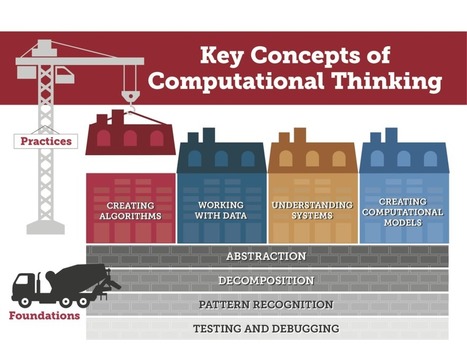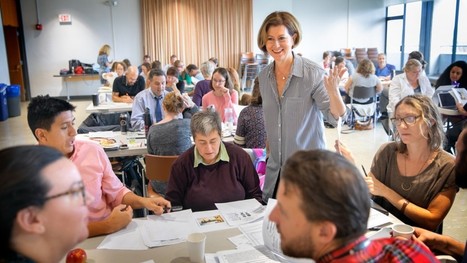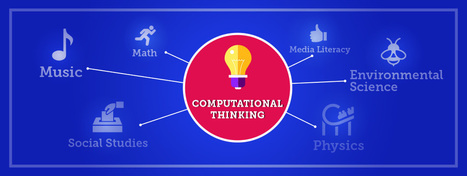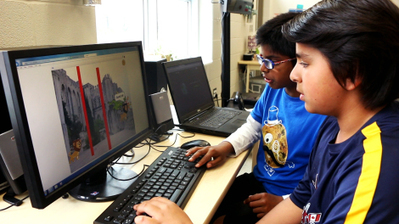 Your new post is loading...
 Your new post is loading...

|
Scooped by
John Evans
|
Across the United States and around the world, educators are being called on to help their students prepare for futures in an increasingly computational world. Integrating computational thinking into activities, lessons, and curricula not only supports building new skills, but also enhances learning and engagement in every discipline.
However, there are still many more educators who do not feel comfortable with computational thinking concepts than those who do.

|
Scooped by
John Evans
|
Computational thinking isn’t new. Three decades ago, Seymour Papert introduced computational thinking when he developed the concept of bricolage, which is the construction of something new from many sources.
He rightly understood the significance of computers, and with computational thinking, he surmised that they would not only be an integral part of our educational process, but we would need to acquire new ways for learning when using computers.
In essence, the bricoleur builds knowledge by engaging in a process of building precise steps that encourage the construction of knowledge. Papert recognized that over time, the learner’s theory may change as the result of refining his or her responses in any of the four stages of computational thinking.
Even before Papert’s work, however, educational visionaries insisted that the way to solve problems in any field was by adopting sequential problem-solving methods, which became algorithmic or computational thinking.
In short, we use computational thinking (CT) to solve problems.

|
Scooped by
John Evans
|
"Coding is the enemy of computational thinking,” Stephen Wolfram announced during his keynote at the Building Learning Communities® Education Conference.
What was remarkable about this comment were the agreeable nods from the crowd. It seemed there was a collective understanding to this notion, and perhaps one that needed further reflection.
This year, the conference had several sessions focusing on computational thinking (which, I might add, is incredibly encouraging to see), and in each one I attended, a special note was added: “Coding and computational thinking are not synonymous.”"

|
Scooped by
John Evans
|
The scientific method is an algorithm. Figuring out what went wrong with a project is a kind of debugging. Breaking a math question into parts is decomposition, and learning history can involve looking for patterns.
“You actually are all already doing some computational thinking without calling it out,” Diane Levitt, senior director of K-12 education at Cornell Tech, told around 60 teachers and administrators from Ithaca and neighboring school districts in a Sept. 28 workshop, “Inspiring a Passion for Computational Thinking,” in Clark Hall. “You can introduce these concepts to your students without even knowing a line of code.”

|
Scooped by
John Evans
|
Forecasts report that computer science skills will be essential for the future workforce, creating a need for K–12 experts to work harder to incorporate such lessons into the curriculum.
According to the App Association, there will be approximately 1 million unfilled computing jobs in 2024. Research conducted by the Bureau of Labor Statistics has found that number could be reached by 2020. These findings have put a fire underneath educators and K–12 organizations to refocus efforts to teach computer science skills.
“We don’t just need computer science graduates to fill computing jobs; we need people with technical abilities to fill jobs in almost every industry,” Victoria Espinel, president of Software.org: the BSA Foundation and chair of the World Economic Forum’s Global Future Council on the Digital Economy and Society, writes in a blog post. “Those jobs will be created by advancements in software, and kids need to prepare now for those possibilities. They won’t all need computer science degrees, but basic digital literacy will be essential.”

|
Scooped by
John Evans
|
The idea behind computational thinking (CT) is problem solving processes that include logically ordering and analyzing data, creating solutions using a series of ordered steps (an algorithm), and dispositions, such as the ability to confidently deal with complexity and open-ended problems. Computational thinking is obviously important in understanding how computers work, but the strategy involved, and way of thinking, can also be applied to many disciplines, including math, humanities, and the sciences. Students who learn computational thinking across their school curriculum have the opportunity to see the connection between subjects, and the real-world applications of the skills they are practicing.

|
Scooped by
John Evans
|
Modern data science emerged in tech, from optimizing Google search rankings and LinkedIn recommendations to influencing the headlines Buzzfeed editors run. But it’s poised to transform all sectors, from retail, telecommunications, and agriculture to health, trucking, and the penal system. Yet the terms “data science” and “data scientist” aren’t always easily understood, and are used to describe a wide range of data-related work.
What, exactly, is it that data scientists do? As the host of the DataCamp podcast DataFramed, I have had the pleasure of speaking with over 30 data scientists across a wide array of industries and academic disciplines. Among other things, I’ve asked them about what their jobs entail.
"Thanks to the successes of campaigns like the Hour of Code and this week’s Computer Science Education Week, educators, policymakers, and families around the country are realizing the value of coding and computer science in K-12 education. But how do “code,” “computer science,” and, “computational thinking,” fit together? What is motivating their introduction into schools, and how might they change education?
Our new report, Computational Thinking for a Computational World, draws from research and interviews with leaders around the country to answer the essential question: In a computational world, what is important to know and know how to do?
The report describes how computational thinking is both central to computer science and widely applicable throughout education and the workforce. It is a skillset for solving complex problems, a way to learn topics in many disciplines, and a necessity for fully participating in a computational world."
|
Across the United States and around the world, educators are being called on to help their students prepare for futures in an increasingly computational world. Integrating computational thinking into activities, lessons, and curricula not only supports building new skills, but also enhances learning and engagement in every discipline.
However, there are still many more educators who do not feel comfortable with computational thinking concepts than those who do.
Computational thinking isn’t new. Three decades ago, Seymour Papert introduced computational thinking when he developed the concept of bricolage, which is the construction of something new from many sources.
He rightly understood the significance of computers, and with computational thinking, he surmised that they would not only be an integral part of our educational process, but we would need to acquire new ways for learning when using computers.
In essence, the bricoleur builds knowledge by engaging in a process of building precise steps that encourage the construction of knowledge. Papert recognized that over time, the learner’s theory may change as the result of refining his or her responses in any of the four stages of computational thinking.
Even before Papert’s work, however, educational visionaries insisted that the way to solve problems in any field was by adopting sequential problem-solving methods, which became algorithmic or computational thinking.
In short, we use computational thinking (CT) to solve problems.

|
Scooped by
John Evans
|
Welcome to Computational Conversations, an interview series where we talk to educators introducing computational thinking into classrooms and curricula. Whether they teach at a high school or develop programs at a university, each interviewee brings new ideas to the table on how to get students and teachers thinking computationally.

|
Scooped by
John Evans
|
How an unsung heroine established a new field of science and helped defeat the Nazis with pencil, paper, and perseverance.

|
Scooped by
John Evans
|
CT and math reasoning
Most coding environments allow teachers to see the student’s code thereby providing a “behind the scenes” look into the thinking that took place to solve the problem. As Marilyn Burns (2005) suggests in Looking at How Students Reason, this visible thinking is important not only when the student’s answer is wrong, but also when it is correct! When I ask students to explain their code, I feel I am getting insight into their thinking – they explain their approach to me and I can then make sense of their reasoning. This helps me to identify and address misconceptions and misunderstandings.
Geometry example: Next time you have students coding shapes to demonstrate their understanding of geometric properties, ask them to explain their code – you’ll most certainly hear key math terms and ideas expressed as well as be able to identify and prescribe next steps, adjusting your lesson accordingly. After all, as Burns suggests “continual evaluation of instructional choices is at the heart of improving our teaching practice” (2005).

|
Scooped by
John Evans
|
Today’s students will enter a workforce that is powerfully shaped by computing. To be successful in a changing economy, students must learn to think algorithmically and computationally, to solve problems with varying levels of abstraction. These computational thinking skills have become so integrated into social function as to represent fundamental literacies. However, computer science has not been widely taught in K-12 schools. Efforts to create computer science standards and frameworks have yet to make their way into mandated course requirements. Despite a plethora of research on digital literacies, research on the role of computational thinking in the literature is sparse. This conceptual paper proposes a three dimensional framework for exploring the relationship between computational thinking and literacy through: 1) situating computational thinking in the literature as a literacy; 2) outlining mechanisms by which students’ existing literacy skills can be leveraged to foster computational thinking; and 3) elaborating ways in which computational thinking skills facilitate literacy development.

|
Scooped by
John Evans
|
I’ve been reading and thinking A LOT about computational thinking (CT) and coding this Winter as part of my work on the Libraries Ready to Code initiative. And by A LOT, I mean A LOT, A LOT. Needless to say, that thinking has not stayed put in my coding programs for older kids and teens, like , or in the Maker Club. It has spilled over into every aspect of my work at the library, including storytime.
Storytime has always been about supporting early literacy (EL) and learning. What is so cool about computational thinking is that it aligns so nicely with so much of what we already do at the library, even in storytime. Every time I mention CT or coding in either storytime or a family program, a grown-up speaks up and makes the connection, on their own, between traditional literacy and code or computational thinking. “Making a program (by connecting blocks of code) is like building a sentence,” for example.
|
 Your new post is loading...
Your new post is loading...
 Your new post is loading...
Your new post is loading...

























